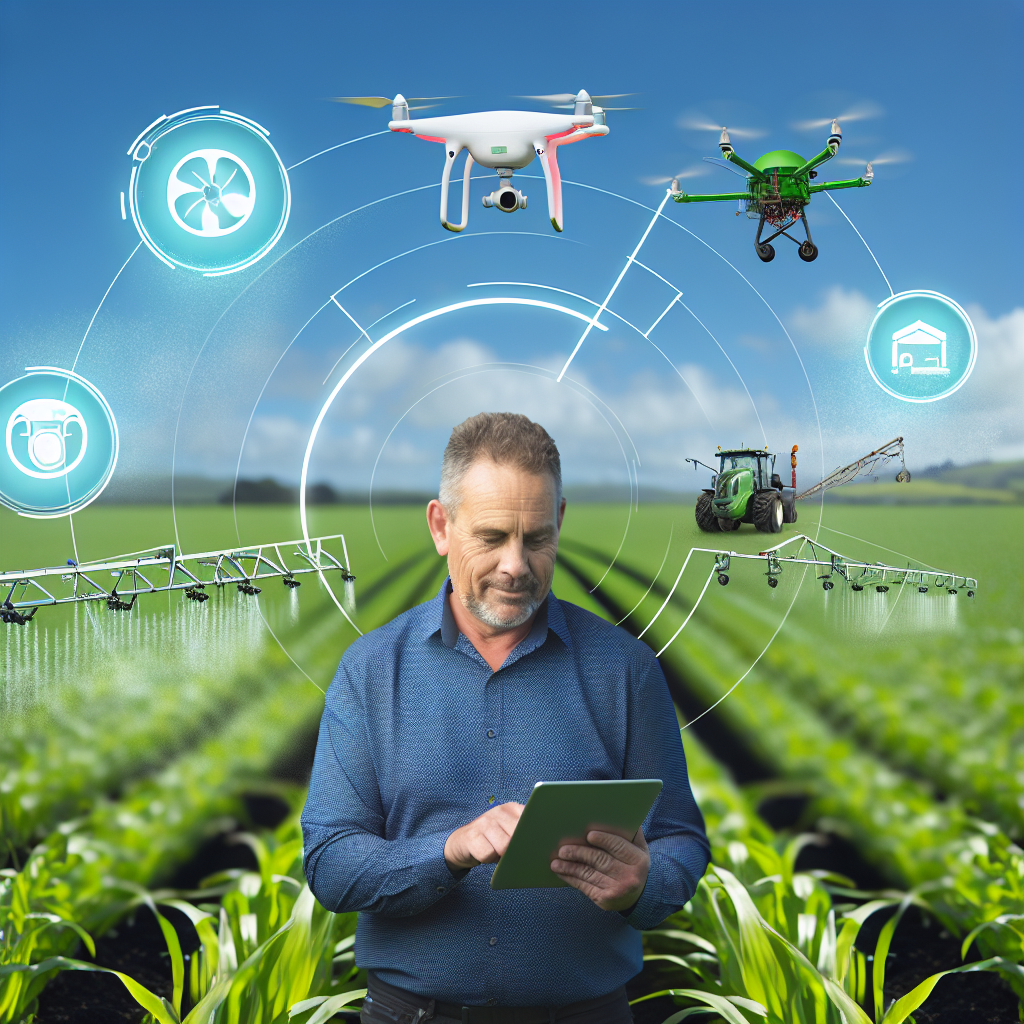Introduction
New Zealand boasts a diverse agricultural landscape.
The country thrives on dairy, meat, and horticulture production.
With over 40% of its land utilized for farming, agriculture plays a critical role in the economy.
New Zealand’s farmers face unique challenges, including climate variability and land management.
To meet the demands of a growing population, they must enhance productivity sustainably.
Technological advancements are reshaping agriculture in exciting ways.
Farmers now rely on modern tools to boost efficiency and production.
These technologies improve crop yields and livestock management.
They also cater to the increasing consumer demand for quality and sustainability.
As a result, utilizing technology becomes essential for New Zealand’s agricultural future.
Agri-tech innovation is the key to unlocking this potential.
It encompasses various technologies, from precision farming to genetic engineering.
Smart farming practices use data analytics to monitor crop health.
This approach helps farmers make informed decisions based on real-time information.
By integrating these technologies, farmers can optimize resource usage and minimize waste.
Personalized Career Consulting
Unlock your potential with expert career advice tailored to your goals. Get personalized guidance and actionable steps toward your dream career in New Zealand.
Get StartedOne exciting area of agri-tech innovation is precision agriculture.
This technique employs GPS tracking and sensor technology.
Farmers can monitor soil conditions, moisture levels, and crop health from their smartphones.
Such immediate access to data supports proactive farming decisions.
Moreover, drones are transforming how farmers survey their land.
They provide high-resolution images that reveal crop health issues.
This timely information enables farmers to address problems before they escalate.
As a result, they can maintain healthier crops and improve overall yields.
The role of agri-tech in New Zealand’s agriculture cannot be overstated.
It enhances productivity while promoting sustainability.
As farmers adopt these smart farming practices, they propel the industry forward.
The future of agriculture in New Zealand looks promising, thanks to continuous innovation.
The Current State of Agriculture in New Zealand
New Zealand agriculture remains a cornerstone of the country’s economy.
Various sectors drive this industry, each contributing significantly to local and global markets.
Transform Your Career with a Professional CV and Cover Letter
Stand out to employers with an ATS-optimized resume and tailored cover letter designed to match your dream role. Let us craft your job application materials for success!
Get StartedHere, we explore key agricultural sectors, economic contributions, and the challenges faced by farmers.
Overview of Key Agricultural Sectors
New Zealand prides itself on diverse agricultural sectors.
Each plays an integral role in the economy and community.
Here are key sectors:
- Dairy: The dairy sector is a powerhouse of New Zealand’s agriculture.
- It accounts for a large share of the country’s export earnings.
- Dairy farming involves milking cows, and processing milk into various products.
- New Zealand’s dairy products, especially milk powder, butter, and cheese, enjoy high international demand.
- The country has approximately 6,500 dairy farms, mainly located in the North Island.
- Sheep: New Zealand is renowned for its sheep farming.
- The country leads globally in lamb production and exports.
- Kiwi farmers often raise both sheep and beef cattle.
- Approximately 29 million sheep roam across the nation, significantly outnumbering the human population.
- Sheep farming not only provides meat but also produces wool, adding to its economic value.
- Horticulture: This sector encompasses fruits, vegetables, and flowers.
- New Zealand’s horticulture industry showcases premium quality produce.
- Avocados, kiwifruit, and berries are among the top exports.
- The sector’s growth reflects increasing global demand for fresh produce.
- Sustainable practices in horticulture are gaining traction, aligning with consumer preferences.
Economic Contribution of Agriculture
New Zealand agriculture significantly influences the national economy.
Agriculture contributes about 10% of the country’s GDP.
Here are some specific contributions:
- Employment: The sector employs nearly 170,000 individuals, forming a critical part of the labor force.
- Many jobs span from farming to processing and distribution.
- Exports: Agricultural products account for over 40% of New Zealand’s total exports.
- Key markets include Asia, Australia, and the United States.
- Regional Development: Agriculture contributes to regional growth.
- Many rural communities depend on farming for livelihood and infrastructure development.
- Innovation and Research: The agriculture sector invests in research and development.
- Innovations enhance productivity and sustainability, influencing economic growth.
Challenges Faced by Farmers
Despite its success, New Zealand’s agriculture faces numerous challenges.
Farmers must adapt to changing circumstances and pressures.
Here are some prevalent challenges:
- Climate Change: Variability in weather patterns threatens agricultural productivity.
- Drier summers and wetter winters disrupt farming cycles.
- Farmers experience both droughts and floods, affecting crop yields.
- Land Degradation: Intensive farming practices lead to soil degradation.
- Loss of soil quality impacts sustainability and future productivity.
- Farmers must focus on conservation to mitigate these effects.
- Labor Shortages: The agriculture sector faces a shortage of skilled labor.
- Many farms are struggling to find workers during peak seasons.
- Additionally, immigration restrictions exacerbate workforce issues.
- Regulatory Pressure: Farmers deal with increasing regulatory requirements.
- Environmental regulations can demand significant changes in farming practices.
- Compliance can lead to increased operational costs.
- Market Volatility: Global markets for agricultural products can fluctuate.
- Prices for products may rise and fall unexpectedly, affecting farmer income.
- Such volatility makes long-term planning challenging for farmers.
New Zealand’s agriculture remains vital to the national economy.
Its diverse sectors contribute significantly to export revenues and employment.
Yet, farmers face ongoing challenges.
Addressing these challenges requires innovation and adaptability.
Boost Your Career with a Standout LinkedIn Profile
Attract recruiters and expand your network with a fully optimized LinkedIn profile tailored to highlight your strengths and professional goals. Let your profile open doors to new opportunities!
Get OptimizedAgri-tech innovations promise to play a crucial role in shaping the future of New Zealand’s agricultural landscape.
Understanding Agri-Tech Innovation
Agri-tech innovation refers to the use of technology in agriculture.
It aims to improve efficiency, sustainability, and productivity.
Many farmers around the world now embrace these technologies to combat challenges.
This section explores various examples, types of technologies, and the significance of data collection in modern farming.
Definition and Examples of Agri-Tech Innovations
Agri-tech innovations encompass various technological advancements in agriculture.
These innovations help farmers practice better resource management and enhance productivity.
Some key examples include:
- Drones: Drones are used for crop monitoring, soil analysis, and pesticide spraying.
- Smart Irrigation Systems: These systems optimize water usage based on real-time weather data.
- Automated Farm Machinery: Self-driving tractors and robotic harvesters reduce labor needs.
- Sensors: Soil and climate sensors provide vital information for timely decision-making.
- Mobile Apps: Farmers utilize apps for market information, farm management, and weather forecasts.
These examples illustrate how technology integrates into daily farming practices.
Farmers can make informed decisions that lead to increased efficiency.
Each innovation carries unique advantages tailored to specific agricultural needs.
Overview of Technology Types Utilized
Several technological tools and techniques facilitate modern agri-tech practices.
They include:
- Drones: Drones collect aerial data for crop monitoring and mapping.
- Internet of Things (IoT): IoT devices connect farm equipment and sensors to provide real-time data.
- Artificial Intelligence (AI): AI algorithms analyze data to provide predictive insights on crop yields.
- Precision Farming Tools: These tools enable targeted action based on specific field conditions.
Each type of technology serves distinct purposes.
Drones enhance visualization of crops, while IoT devices gather actionable data.
AI helps in predicting outcomes and optimizing interventions.
Precision farming tools focus on resource conservation and maximizing yield.
The Significance of Data Collection in Modern Farming Practices
Data collection plays a pivotal role in modern agriculture.
It allows farmers to monitor and manage their farms effectively.
Continuous data collection leads to improved decision-making.
The importance of data collection includes:
- Enhanced Crop Management: Data helps farmers understand crop health and performance.
- Resource Optimization: Accurate data enables efficient use of water, fertilizers, and pesticides.
- Risk Management: Data analytics help identify potential risks and mitigate them proactively.
- Yield Prediction: Historical data enhances the accuracy of yield forecasts for better planning.
- Cost Reduction: Efficient resource management ultimately reduces operational costs.
By embracing data-driven farming, producers can adapt to changing climate conditions.
They can also respond to market demands more effectively.
Data collection technologies instill confidence in strategic decision-making, thereby reducing uncertainties.
Implications of Agri-Tech Innovation
Agri-tech innovation reshapes New Zealand’s agricultural landscape.
By adopting advanced technologies, farmers enhance productivity and sustainability.
This technological evolution ensures that farmers are equipped for the challenges ahead.
The integration of drones, IoT, AI, and precision farming tools leads to a holistic improvement in farming practices.
In a world facing growing food demand, these innovations provide essential solutions.
Understanding agri-tech lays a solid foundation for future advances in agriculture.
Uncover the Details: Why Livestock Specialists Are Key to NZ’s Meat and Dairy Industries
Agri-tech Innovation in New Zealand
Agri-tech innovation is rapidly transforming New Zealand’s agricultural landscape.
Farmers are increasingly adopting technology to enhance productivity and sustainability.
Below are case studies that highlight successful agri-tech implementation in New Zealand:
Case Study 1: Drones for Crop Monitoring
Drones represent a game-changing technology in agriculture.
A New Zealand farm, located in the Waikato region, incorporated drones into its operations.
This farm specializes in growing diverse crops, including kiwifruit and avocados.
- Precision Mapping: The farm utilizes drones equipped with multispectral cameras. These cameras capture images that reveal crop health, soil quality, and moisture levels.
- Real-Time Data: Drones provide real-time data, allowing farmers to make informed decisions promptly. This leads to better resource management and reduced waste.
- Cost Efficiency: By using drones, the farm has significantly reduced labor costs. They can cover large areas in a fraction of the time compared to traditional methods.
- Insect and Weed Monitoring: Drones help in identifying pest-infested areas quickly. This allows farmers to target interventions more effectively, reducing pesticide use.
The use of drones has improved the farm’s overall efficiency.
Increased crop yields and reduced costs have made a significant difference.
Drones have also enhanced the farm’s ability to respond to environmental changes.
Case Study 2: Precision Irrigation Systems
Another remarkable advancement in New Zealand’s agriculture is the use of precision irrigation systems.
A vineyard in Marlborough implemented this system to optimize water use efficiently.
- Soil Moisture Sensors: The vineyard deployed soil moisture sensors to monitor hydration levels. This information helps determine when to irrigate.
- Automated Irrigation: The system adjusts irrigation schedules automatically, based on real-time data. This ensures that vines receive the right amount of water.
- Water Conservation: By using precision irrigation, the vineyard has reduced water consumption significantly. This practice is vital in a region with limited water resources.
- Improved Grape Quality: Consistent moisture levels contribute to better grape quality. The vineyard has reported increased wine quality as a result.
This vineyard’s integration of precision irrigation has reduced operational costs and improved sustainability.
This case showcases the potential of agri-tech to enhance agricultural practices while conserving resources.
Case Study 3: AI in Livestock Management
Artificial intelligence is transforming livestock management in New Zealand.
A sheep farm in Otago implemented AI-based technologies to monitor herd health and behavior.
- Health Monitoring: The farm uses wearable sensors on sheep that track health indicators. These sensors monitor heart rate, temperature, and activity levels.
- Behavior Analysis: AI algorithms analyze behavior patterns to identify stress or illness. This allows farmers to act quickly when issues arise.
- Feeding Optimization: AI also assists in optimizing feed formulations tailored to individual animal needs. This promotes better health and productivity among the flock.
- Data-Driven Decisions: The farm uses AI-generated analytics to inform breeding and culling decisions. This leads to better genetic diversity and overall herd performance.
The adoption of AI on this sheep farm has improved animal welfare and operational efficiency.
Farmers can now manage larger herds with fewer resources, increasing profitability.
The case studies outlined above demonstrate the transformative power of agri-tech innovation in New Zealand.
Each implementation of technology contributes to improved efficiency, sustainability, and profitability.
Farmers are not merely adopting technology; they are revolutionizing traditional practices for modern challenges.
New Zealand’s forward-thinking approach to agriculture embraces the benefits of technology.
As farmers continue to integrate advanced systems, they position themselves for future success.
The journey of agri-tech is just beginning, and its potential is vast.
With the support of innovation, New Zealand’s agricultural sector can thrive in the face of global challenges.
The future of farming depends on technologies that adapt to changing climates and consumer demands.
Embracing these changes will foster a more resilient and productive agricultural industry.
You Might Also Like: How Organic Farming Careers Are Thriving in New Zealand
Economic and Environmental Benefits of Smart Farming
Smart farming technologies are revolutionizing New Zealand’s agricultural landscape.
These innovations lead to significant economic and environmental benefits.
Farmers increasingly adopt smart farming practices to ensure sustainability and profitability.
Below, we explore the key advantages of embracing smart farming in New Zealand.
Increased Productivity and Efficiency in Resource Use
Smart farming introduces precision agriculture techniques.
These methods focus on maximizing crop yields while minimizing inputs.
Key practices include:
- Data-Driven Decision Making: Farmers use big data analytics to make informed choices.
- Automated Irrigation Systems: These systems monitor moisture levels precisely.
- Precision Fertilization: Farmers can apply fertilizers with pinpoint accuracy.
- Yield Monitoring Tools: Advanced sensors and drones help farmers track production progress.
As a result, farmers achieve higher yields per hectare.
They also reduce input costs through optimal resource use.
This creates a win-win situation—more profits while safeguarding the environment.
Reduction in Environmental Impact through Sustainable Practices
Smart farming significantly lessens the ecological footprint of agriculture.
Advanced technologies promote sustainable practices that protect natural resources.
Some critical approaches include:
- Soil Health Management: Farmers implement cover cropping and crop rotation.
- Integrated Pest Management (IPM): By utilizing biological controls and targeted pest treatments, farmers minimize pesticide use.
- Carbon Sequestration: Practices such as agroforestry increase carbon storage in soils.
- Water Conservation Techniques: Smart farming practices focus on maintaining water quality.
By adopting these practices, New Zealand farmers contribute to global sustainability goals.
They enhance biodiversity while ensuring healthy ecosystems for future generations.
Long-Term Economic Growth for Farmers through Reduced Overhead Costs
The implementation of smart farming solutions leads to significant economic advantages.
Farmers can achieve long-term growth by decreasing operational costs.
Key factors contributing to this include:
- Lower Input Requirements: Smart technologies reduce the need for fertilizers, pesticides, and water.
- Increased Efficiency: Automation and smart machinery streamline operations.
- Market Access: By utilizing data analytics, farmers predict market trends effectively.
- Investment in Research and Development: As farmers embrace innovation, they often participate in R&D projects.
With reduced overhead costs, farmers can reinvest savings into their operations.
This investment fuels business expansion, leading to economic resilience in New Zealand’s agriculture sector.
Future of Smart Farming in New Zealand
Smart farming in New Zealand showcases a progressive shift in agricultural practices.
The economic and environmental benefits are clear and compelling.
By increasing productivity through precision techniques, farmers enjoy higher yields while lowering costs.
Sustainable practices reduce environmental impacts and enhance soil and water health.
Moreover, long-term economic growth is achievable through smart farming innovations.
As New Zealand moves forward, embracing smart farming technologies becomes increasingly critical.
The integration of these practices promises not only to bolster the agriculture sector but also to ensure a sustainable future for generations to come.
In the face of climate change and global food security challenges, smart farming emerges as a vital solution for farmers worldwide.
Discover More: Precision Agriculture: High-Tech Farming Jobs Transforming NZ’s Landscape

Challenges and Barriers to Adoption
Despite the many benefits of agri-tech innovation, significant barriers hinder its widespread adoption in New Zealand’s agriculture.
Understanding these challenges is crucial for addressing them effectively.
Here are several key obstacles faced by farmers:
Resistance Among Traditional Farmers
Many traditional farmers often hesitate to embrace new technologies.
Deep-rooted practices and a reliance on conventional methods contribute to this resistance.
Farmers may view technology as a threat to their established ways.
Cultural and generational beliefs also play a significant role in this reluctance.
Additionally, some farmers worry that technology may reduce human labor, disrupting their communities.
This mindset creates a significant barrier to the adoption of smart farming systems.
High Initial Costs and Investment Concerns
The financial implications of adopting agri-tech can be daunting.
Initial setup costs for smart farming technologies can be high.
For many farmers, this represents a significant financial risk.
They may have limited access to financing options to support these transitions.
Concerns about return on investment (ROI) often deter farmers from making initial investments.
They frequently struggle to see the tangible benefits within a reasonable timeframe.
These investment concerns create trepidation amongst those looking for immediate benefits.
Need for Education and Training
The knowledge gap regarding new technologies poses another challenge.
Many farmworkers lack familiarity with modern tools and systems.
This deficiency necessitates extensive education and training resources.
Without proper training, workers may feel overwhelmed by new systems.
This lack of confidence can lead to improper usage of technology.
Employers must invest time and resources into upskilling their workforce.
Moreover, training needs to be continuous to keep pace with evolving technology.
Integration with Existing Systems
Farm operations often rely on a mix of traditional and modern practices.
Integrating new technologies with existing systems can prove complex.
Compatibility issues may arise between old systems and new technologies.
Farmers may face technical challenges when trying to combine different tools.
This integration difficulty can lead to frustration and wasted resources.
Data Privacy and Security Concerns
As farming becomes more data-driven, concerns about data privacy and security increase.
Farmers may worry about who has access to their data.
Questions about data ownership and usage rights can deter adoption.
The risk of cyberattacks also poses a significant threat.
Many farmers feel unprepared to address these threats effectively.
A fear of losing sensitive information can lead to resistance against data-driven technologies.
Lack of Local Support Networks
The absence of robust local support networks can further impede technology adoption.
Farmers in remote areas may feel isolated from innovation hubs.
Limited access to expertise can create a gap in effective implementation.
Support for technology adoption often comes from urban centers, leaving rural areas underserved.
Without localized resources, farmers may struggle to navigate challenges.
Local agricultural extension services can play a vital role in bridging this gap.
However, many farmers remain unaware of these resources.
Perceived Complexity of Technology
Many farmers view modern agricultural technologies as too complex.
This perception can lead to avoidance rather than exploration of new tools.
The learning curve associated with these technologies can seem daunting.
Farmers may fear they lack the technical expertise to operate new systems.
Consequently, they may choose to remain with familiar practices.
Addressing perceived complexity through user-friendly designs is essential for encouraging adoption.
Market Pressure and Changing Consumer Demands
The agricultural market continuously evolves with changing consumer demands.
Farmers face pressure to produce higher-quality products sustainably.
However, digital transition can feel like an overwhelming task amidst these pressures.
The speed of technological change can exceed the ability of farmers to adapt.
Many are left feeling anxious about keeping up with expectations.
This stress can hinder the willingness to embrace innovation.
Regulatory Barriers
Farmers must navigate various regulations related to agricultural technologies.
Compliance with local and national regulations can be challenging.
This complexity may deter farmers from investing in new innovations.
Understanding regulations in relation to technology adoption requires additional support.
Authorities must work collaboratively with farmers to streamline compliance processes.
Seasonal Work Cycles
The agricultural calendar revolves around seasons, impacting the time available for training and technology implementation.
Farmers may feel they lack adequate time to adopt new technologies during peak seasons.
This cyclical nature of farming makes it hard to find windows for learning and integration.
Consequently, many technology adoption efforts end up being postponed indefinitely.
Strategies for Overcoming Barriers
Addressing these challenges requires a multifaceted approach.
Stakeholders must work together to encourage the adoption of smart farming.
Governments, educational institutions, and technology providers can assist farmers.
Creating an environment that fosters innovation is essential.
Education, financial support, and community engagement will pave the way for a more technologically advanced agricultural future in New Zealand.
Gain More Insights: The Sustainable Farming Revolution in NZ That Is Improving Crop Yields
Future Trends in Agri-Tech for New Zealand
Agri-tech is set to revolutionize New Zealand’s agriculture.
Emerging technologies are reshaping farming practices.
They improve productivity and sustainability.
As the world embraces innovative solutions, New Zealand stands at the forefront of this transformation.
Innovations on the Horizon
Several promising innovations are poised to change agricultural practices in New Zealand.
These advancements will enhance food production while minimizing environmental impact.
Here are key innovations to watch for:
- Vertical Farming: This approach focuses on growing food in stacked layers, using controlled environments.
- Biotechnology: Genetic engineering and molecular biology enable farmers to develop crops resistant to pests and diseases.
- Smart Irrigation Systems: These systems utilize sensors to monitor soil moisture and weather conditions.
- Drone Technology: Drones offer aerial imagery and real-time data on crop health.
- Precision Agriculture: Utilizing GPS and data analytics, farmers can fine-tune their practices.
Potential Impact of Advancements in AI and Machine Learning
Artificial intelligence (AI) and machine learning are crucial drivers of change in agri-tech.
These technologies analyze vast amounts of data to improve farming efficiency.
Here are some potential impacts of AI and machine learning on agriculture:
- Predictive Analytics: AI can analyze weather patterns and soil conditions, helping farmers make better decisions.
- Yield Optimization: Machine learning algorithms can assess past data to predict future crop performance.
- Automated Farming Equipment: Robotics and AI-powered machinery can perform tasks like planting and harvesting.
- Pest and Disease Detection: AI can identify signs of pest infestations or plant diseases early.
- Supply Chain Efficiency: AI optimizes the agricultural supply chain, reducing waste and improving market access.
Predictions for the Evolution of Agri-Tech in New Zealand’s Agriculture Industry
As New Zealand continues to embrace agri-tech, industry experts predict exciting developments.
These predictions reflect the ongoing evolution of technology in agriculture:
- Increase in Collaboration: Partnerships between tech companies and farmers will grow.
- Sustainability Focus: New Zealand will place a greater emphasis on sustainable farming practices.
- Enhanced Data Utilization: Farmers will increasingly rely on data to inform their practices.
- Greater Accessibility of Technology: As technology becomes more affordable, more farmers will adopt innovative solutions.
- Regulatory Changes: The New Zealand government is likely to introduce policies to support agri-tech adoption.
New Zealand’s agricultural sector stands on the brink of significant transformation.
The integration of innovative technologies presents opportunities for growth and sustainability.
By embracing these advancements, farmers can meet future food demands while preserving natural resources.
As agri-tech evolves, it will impact not only the agriculture industry but also the economy and environment of New Zealand.
Sustainable practices will become the norm, and smart farming will redefine how we think about food production.
The future of agri-tech in New Zealand looks promising.
Innovations like vertical farming and biotechnology pave the way for efficiency gains.
Coupled with AI and machine learning’s capabilities, farmers can achieve unprecedented levels of production accuracy.
As these trends unfold, New Zealand could lead the way in global agricultural practices.
Farmers, researchers, and policymakers must collaborate to unlock the full potential of agri-tech.
Together, they can create a resilient agricultural sector capable of meeting future challenges.
Agri-Tech Innovation for New Zealand’s Future
Agri-tech innovation offers transformative potential for New Zealand’s agricultural landscape.
These advancements help farmers increase productivity and sustainability.
By harnessing technology, they reduce their environmental impact while enhancing crop yields and livestock health.
Smart farming techniques like precision agriculture incorporate data analytics.
This allows farmers to optimize resource use, making every drop of water and ounce of fertilizer count.
Continued investment in agri-tech is crucial for ensuring New Zealand maintains its competitive edge.
As global demand for food rises, so does the need for innovative solutions.
Technologies such as drones, IoT sensors, and AI-driven analytics empower farmers with real-time information.
This leads to more informed decisions and improved outcomes across the board.
Support from government, educational institutions, and tech developers will accelerate the adoption of these technologies.
Policymakers should create favorable regulations that foster innovation while ensuring sustainability.
Farmers need training and resources to integrate new tools effectively into existing practices.
Collaboration between all stakeholders is essential for developing comprehensive solutions.
We need to work together for a sustainable agricultural future in New Zealand.
The challenges facing agriculture are significant, but they are not insurmountable.
With a united approach, we can leverage agri-tech to enhance productivity and sustainability.
Let us invest in this mission—transforming farming practices and securing food sources for generations to come.
The future of agriculture in New Zealand relies on embracing technological advances.
Policymakers, farmers, and tech developers must join forces.
Together, we can create a thriving, resilient agricultural sector that benefits everyone.
Additional Resources
Agritech in New Zealand – INDUSTRY TRANSFORMATION PLAN
Co-operative Research Programme: Sustainable Agriculture and …




